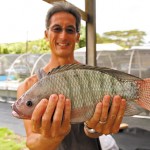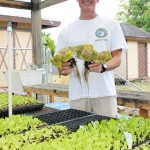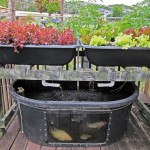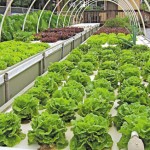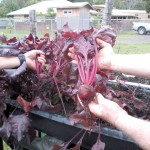Food For Thought
More than 800 million people in the world are hungry — many are children — and the number continues to climb. It is a distressing statistic people like Bernie Tsao want to reverse.
- Bernie Tsao teaches an aquaponics class at KCC that allows graduates to grow amazing vegetables fertilized by fish such as this tilapia. Photo courtesy Bernie Tsao
- Bernie Tsao teaches aquaponics at KCC COCO ZICKOS PHOTO
- An aquaponics system like this can feed, on average, a family of four PHOTO COURTESY BERNIE TSAO
- The hydroponic beds at KCC
- Beets are just one of the many vegetables that can be grown successfully in an aquaponics system PHOTOS COURTESY BERNIE TSAO
“That’s a really big part of my heart,” he says.
Tsao, an aquaculture and aquaponics consultant, attributes world hunger to issues such as politics and money, and not because food can’t be produced.
“So much food is being wasted,” he explains.
His passion is to teach people how to rely on their own food production and become more self-sustaining. Through the Office of Continuing Education (OCET) at Kauai Community College, Tsao is sharing his knowledge of aquaponics with others.
Aquaponics is the combination of aquaculture (fish farming) and hydroponics. Plants and vegetables are grown in a soilless medium where water is circulated from tanks filled with fish, whose waste supplies nutrients for the plants.
The system is not as simple as it sounds. It is a fine-tuned science that must be learned and administered properly. For example, bacterium naturally found in the environment uses ammonia from the fish waste and breaks it down into a final product of nitrate, which is what fertilizes the plants. Ammonia is toxic to fish, and factors such as the right habitat size and the correct amount of bacteria must be in place in order to create a precise system.
“Everything has to be in balance,” says Tsao, whose company is He Wai E Ola (Living Water) Aquaponics.
The hands-on learning environment that KCC provides, which includes tilapia grow-out tanks, a water-harvesting catchment system and hydroponic grow beds, is the perfect resource for people wanting to learn how to run a large-scale operation, as well as create their own small, family-friendly system. Five-hour-long workshops held every
Saturday for five weeks allow students to learn everything from basic fundamentals of aquaponics to water chemistry, design and construction of the systems, including how to size the right kinds of pumps, installation and how to manage different species of fish, as well as marketing.
The benefits of knowing how to operate these systems are plentiful. First, no chemicals are needed and soil-related pathogens and pests are omitted from the process. There is no tilling of soil, no amendments to add and no bending over to weed.
“It’s great, especially for someone like me who’s not getting any younger,” jokes Tsao.
Virtually any type of plant can be harvested, including a wide range of produce, including lettuce and carrots, which all grow two to three times faster than they do in soil and use a fraction of the water. The fish are an added bonus as they also can provide food. In tropical climates, tilapia is typically used, although Asian walking catfish or even koi work well.
Tsao dreams of every family having their own systems at home, as they are designed to fit on a lanai or in a backyard, easy to maintain, relatively inexpensive to install and can feed up to six people.
“Every family can take responsibility to feed their own family,” says Tsao, who once had a system that provided more than his family could eat, so they always shared with friends.
“That just tells you, if everybody did this, no one would need to go to the grocery store,” he adds.
Feeding people has been a goal of Tsao’s since he was a child. Born in Hong Kong and raised in California, he says he always had a “calling” to grow food. Tsao graduated from University of California at Santa Barbara with a degree in aquatic biology, but didn’t actually dive into his career until he went back to school to learn mechanical engineering at Santa Barbara City College. Prior to that, Tsao earned a living shaping surfboards. However, the ringing of wedding bells with his wife, Susan (with whom he has three adult children, Janelle, Cassiee and Titus), inspired him to get serious about his career.
“All of a sudden, I woke up and realized there was more to life than just me,” he says.
He moved his family to Kona in 1989, where he started a training program and taught fish farming for 11 years. And before eventually settling on Kauai (which he discovered when he lived in California and was “looking for waves”), Tsao moved to Fiji and continued teaching aqua-culture for six years.
He is happy to bring his knowledge to the Garden Isle and is thankful for the island’s abundance of high-quality water.
“Kauai is the perfect island for freshwater aquaculture, but there’s the least amount of activities here,” he says.
Tsao is optimistic that things will change.
For more information on the next Introduction to Aquaponics Systems workshop, which will commence Oct. 18, visit kauai.hawaii.edu/training or contact Tsao at bernie@livingwateraquaponics.com.
cocomidweek@gmail.com

